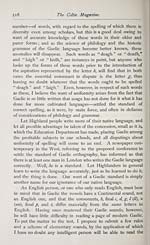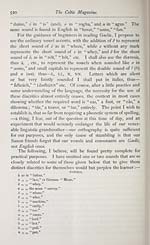Blair Collection > Celtic magazine > Volume 12
(529)
Download files
Complete book:
Individual page:
Thumbnail gallery: Grid view | List view

Gaelic Orthography. 519
Gaelic language with a surprising degree of correctness. There
are a few sounds in Gaelic which are generally regarded as un-
pronounceable by an Englishman. One of the worst of these is
the double sound of /, as in "la," a day ; and the word " laogh,"
a calf, is usually put forward as a perfect settler, as it, in addition
to this double / sound, contains other two posers, namely, ao and
gh. But, in point of fact, the word need present no more diffi-
culty to a courageous Saxon than the harmless animal with which
it is identified. In fact, its final sound, that of gh — the one
usually considered the least in point of difficulty — is the one most
difficult to convey to an Englishman, unless, indeed, we simply
tell him to regard it as the rr of the Newcastle burr. The sound
of the initial /in "laogh" is one that English speakers pronounce
every day without knowing it. It is a combination of / and the
th in the English word " that." Place the tongue in the position
for /, and, while pronouncing that letter, slip the tip of the tongue
down to the points of the teeth as if for th, and you have the exact
sound of the Gaelic / in "laogh," and // in "call," "null," and,
in fact, wherever // is preceded by a broad vowel. Indeed, a
more simple instruction might be to place the tongue as for th
{dh), and sound /. The broad sound of n {nn) is to be treated in
an exactly similar way. It is a combination of n and th, {dh). The
sound oi ao in "laogh" is, as it is invariably elsewhere, long, and
is the same as the cen of the French, or the u of the English word
" purr," lengthened out.
A peculiar philological fact with reference to // and Jin is that
in old Gaelic they are very frequently Id and 7id. The change of
this d into dh gives at once the combined sounds Ith and nth, to
which I have been referring.
Before going further I may mention one or two defects in our
Gaelic orthography. These are the want of a symbol to distin-
guish the various sounds of the letters / and n. To a person who
understands the language the matter presents no great difficulty,
but to a beginner in Gaelic reading they are a little perplexing,
there being nothing necessarily in their proximity to certain
vowels, to indicate their sound, as in the case of the other con-
sonants. We require also a symbol to denote the indefinite short
unaccented sound of the vowels — the sound of a in " cionta," e in
Gaelic language with a surprising degree of correctness. There
are a few sounds in Gaelic which are generally regarded as un-
pronounceable by an Englishman. One of the worst of these is
the double sound of /, as in "la," a day ; and the word " laogh,"
a calf, is usually put forward as a perfect settler, as it, in addition
to this double / sound, contains other two posers, namely, ao and
gh. But, in point of fact, the word need present no more diffi-
culty to a courageous Saxon than the harmless animal with which
it is identified. In fact, its final sound, that of gh — the one
usually considered the least in point of difficulty — is the one most
difficult to convey to an Englishman, unless, indeed, we simply
tell him to regard it as the rr of the Newcastle burr. The sound
of the initial /in "laogh" is one that English speakers pronounce
every day without knowing it. It is a combination of / and the
th in the English word " that." Place the tongue in the position
for /, and, while pronouncing that letter, slip the tip of the tongue
down to the points of the teeth as if for th, and you have the exact
sound of the Gaelic / in "laogh," and // in "call," "null," and,
in fact, wherever // is preceded by a broad vowel. Indeed, a
more simple instruction might be to place the tongue as for th
{dh), and sound /. The broad sound of n {nn) is to be treated in
an exactly similar way. It is a combination of n and th, {dh). The
sound oi ao in "laogh" is, as it is invariably elsewhere, long, and
is the same as the cen of the French, or the u of the English word
" purr," lengthened out.
A peculiar philological fact with reference to // and Jin is that
in old Gaelic they are very frequently Id and 7id. The change of
this d into dh gives at once the combined sounds Ith and nth, to
which I have been referring.
Before going further I may mention one or two defects in our
Gaelic orthography. These are the want of a symbol to distin-
guish the various sounds of the letters / and n. To a person who
understands the language the matter presents no great difficulty,
but to a beginner in Gaelic reading they are a little perplexing,
there being nothing necessarily in their proximity to certain
vowels, to indicate their sound, as in the case of the other con-
sonants. We require also a symbol to denote the indefinite short
unaccented sound of the vowels — the sound of a in " cionta," e in
Set display mode to: Large image | Transcription
Images and transcriptions on this page, including medium image downloads, may be used under the Creative Commons Attribution 4.0 International Licence unless otherwise stated. ![]()
| Early Gaelic Book Collections > Blair Collection > Celtic magazine > Volume 12 > (529) |
|---|
| Permanent URL | https://digital.nls.uk/76466849 |
|---|
| Description | Volume XII, 1887. |
|---|---|
| Shelfmark | Blair.13 |
| Attribution and copyright: |
|
| Description | A selection of books from a collection of more than 500 titles, mostly on religious and literary topics. Also includes some material dealing with other Celtic languages and societies. Collection created towards the end of the 19th century by Lady Evelyn Stewart Murray. |
|---|
| Description | Selected items from five 'Special and Named Printed Collections'. Includes books in Gaelic and other Celtic languages, works about the Gaels, their languages, literature, culture and history. |
|---|

